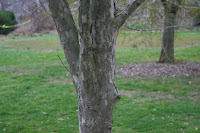European Larch, Common Larch
Pinaceae
This tree is located on the grounds of the Biddle family estate at Andalusia, Pennsylvania.
http://www.andalusiapa.org/
'Pendula' - This cultivar is an umbrella for various pendulous forms which are usually grafted on a standard to form a small weeping tree.


More information is available at the University of Connecticut plant database:
http://www.hort.uconn.edu/plants/l/lardec/lardec1.html
- native to North and Central Europe
- Zone 2
- deciduous conifer
- 80' to 100' tall by 20' to30' wide
- pyramidal in habit with horizontal branches and weeping branchlets
- becomes more irregular with age
- fine to medium texture, coarse in winter
- moderate growth rate
- soft, flat needles
- 1" to 1.25" long
- bright green in spring, darkening with maturity
- found in groups on spurs or in a spiral arrangement down long branches

















